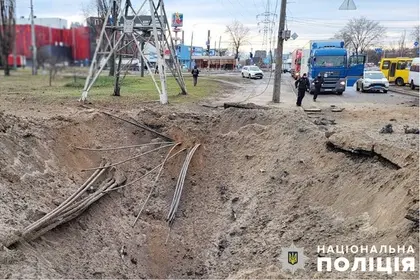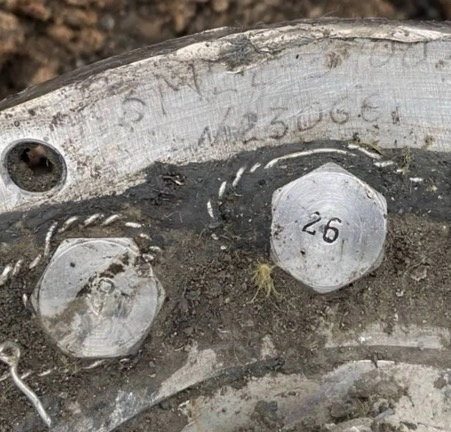Among the debris found following the Feb. 7 Russian missile attack on Ukraine, was what appears to be the remnants of a 3M22 Tsirkon (or Zircon) hypersonic missile which was one of Moscow’s “wonder weapons” first revealed in March 2018.
The 3M22 was not included in the official breakdown of missiles shot down during Wednesday’s attack given by Ukrainian Air Force’s, which only mentioned Kh-555/101 and Kalibr cruise and Shahed drones. However, earlier in the morning, they had warned of the approach of a “high-velocity missile” towards Kyiv.
JOIN US ON TELEGRAM
Follow our coverage of the war on the @Kyivpost_official.
Military commentators feel that, as the wreckage was found adjacent to powerlines in the Dniprovsky district of Kyiv, this was an unlikely target for a multi-million-dollar missile, making it probable that it was indeed shot down by Ukrainian air defense.
The Monitor Telegram channel first drew attention to the missile as being “something different” and said had been fired from a land-based launcher in occupied Crimea.
They described the missile as flying on an “atypical trajectory,” different, but similar, to that previously witnessed when Onyx and Kinzhal missiles were fired on Ukraine.
Debris of possible 3M22 Tsirkon missile found Dniprovsky district of Kyiv
Photo: Monitor Telegram
While markings on the missile wreckage indicated that it was indeed from a Tsirkon, they seem to be hand written which, along with the fact it did not reach hypervelocity during flight, casts some doubt on its identification. It is possible that this was a “prototype” and another example of Russia deploying a “test sample” to see how it would perform.

Zelensky’s Top General Syrsky Admits Ukraine’s Army Faces Challenges – But Says Fixes Are Coming
Russia’s armed forces test-fired the Tzirkon in public for the first time in December 2022, after which Putin announced that from the following January Russian ships, specifically the newly-commissioned Admiral Gorshkov frigate and the Severodvinsk nuclear submarine, would be armed with the weapon.
Tzirkon was slated to replace the P-700 Granit and P-800 Oniks anti-ship missiles using the universal UKSK 3S14 missile launcher, in a move the Kremlin described as making Moscow's international security guarantees “more convincing.”
Little is really known about the Tzirkon other than the few details Russia has let slip and its designation as a hypervelocity is based purely on those. It has not been seen to achieve such speed either during its earlier testing or on this operational deployment.
So far, the exact tactical and technical characteristics of the product have not been officially reported with publicly released specifications changing over time.
Russia’s Ministry of Defense announced it had been accepted into service in June 2022 and mass production would start immediately. At the time they mentioned it would have a 300-kilogram warhead, a range of 400 kilometers and a flight speed of Mach 6 (Mach 5 being the usually recognized hypervelocity threshold).
During his December 2022 announcement, however, Putin claimed a range of 1,000 kilometers at a speed of Mach 9.
As neither of the naval vessels known to carry the missile have access to the Black Sea, because of Turkish-imposed constraints, and Monitor’s suggestion the missile was fired from land in the Crimean Peninsula there are questions concerning the platform used to launch the Tsirkon (if that is what it was).
The most likely candidate seems to be the K-300 Bastion coastal defense system which had earlier been adapted to fire the Oniks anti-ship missiles for attacks on residential areas, infrastructure, grain storage and handling facilities in Odesa.
While, if the wreckage recovered in Kyiv is from a Tsirkon, it would suggest that it is likely to be as vulnerable to Ukraine’s more capable air defense systems such as Patriot as the KH72 Kinzhal has been.
The greater threat is, however, because unlike the “early warning” that take-off of the MIG-31Ks which carry the Kinzhals gives a land-based system can be launched without prior warning.
You can also highlight the text and press Ctrl + Enter











